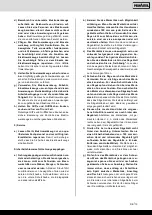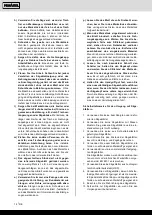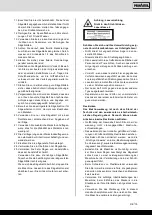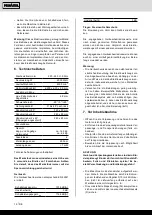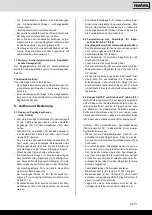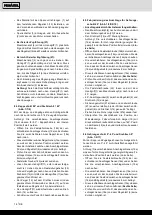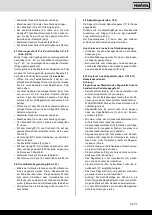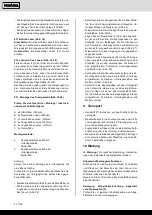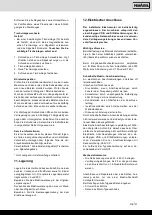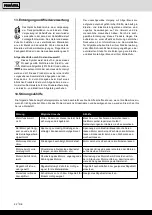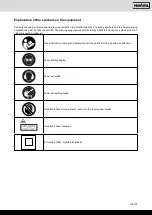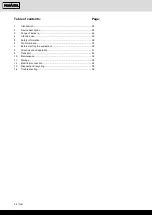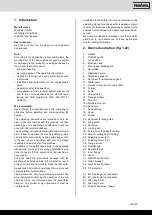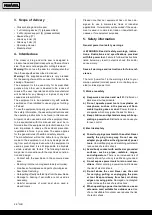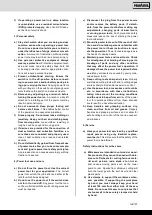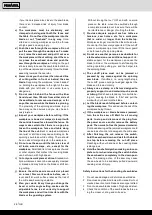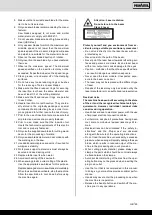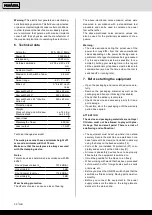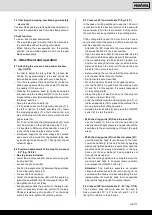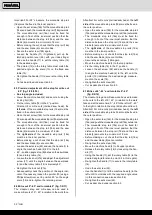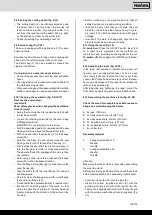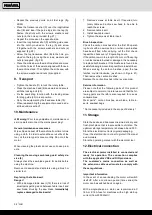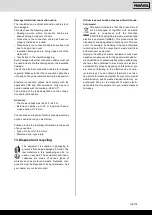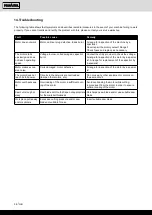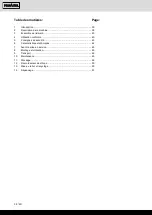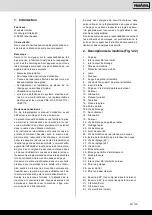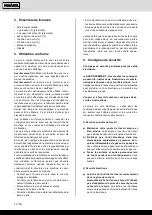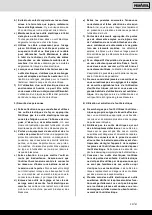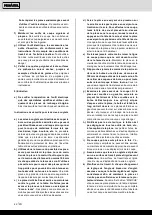
GB | 27
c) Disconnect the plug from the power source
and/or remove the battery pack, if detach-
able, from the power tool before making any
adjustments, changing parts of insert tools,
or storing power tools.
Such preventive safety
measures reduce the risk of starting the power
tool accidentally.
d) Store idle power tools out of the reach of chil-
dren and do not allow persons unfamiliar with
the power tool or these instructions to oper-
ate the power tool.
Power tools are dangerous in
the hands of untrained users.
e) Maintain power tools and insert tools. Check
for misalignment or binding of moving parts,
breakage of parts and any other condition
that may affect the power tool’s operation. If
damaged, have the power tool repaired before
use.
Many accidents are caused by poorly main-
tained power tools.
f) Keep cutting tools sharp and clean.
Properly
maintained cutting tools with sharp cutting edges
are less likely to bind and are easier to control.
g) Use the power tool, accessories and tool bits
etc. in accordance with these instructions,
taking into account the working conditions
and the work to be performed.
Use of the power
tool for operations different from those intended
could result in a hazardous situation.
h) Keep handles and grasping surfaces dry,
clean and free from oil and grease.
Slippery
handles and grasping surfaces do not allow for
safe handling and control of the tool in unexpect-
ed situations.
5) Service
a)
Have your power tool serviced by a qualified
repair person using only identical replace-
ment parts.
This will ensure that the safety of the
power tool is maintained.
Safety instructions for mitre saws
a) Mitre saws are intended to cut wood or wood-
like products, they cannot be used with abra-
sive cut-off wheels for cutting ferrous mate
-
rial such as bars, rods, studs, etc.
Abrasive
dust causes moving parts such as the lower
guard to jam. Sparks from abrasive cutting will
burn the lower guard, the kerf insert and other
plastic parts.
b) Use clamps to support the workpiece when-
ever possible. If supporting the workpiece
by hand, you must always keep your hand
at least 100 mm from either side of the saw
blade. Do not use this saw to cut pieces that
are too small to be securely clamped or held
by hand.
f) If operating a power tool in a damp location
is unavoidable, use a residual current device
(RCD) protected supply.
Use of an RCD reduc-
es the risk of electric shock.
3) Personal safety
a) Stay alert, watch what you are doing and use
common sense when operating a power tool.
Do not use a power tool while you are tired or
under the influence of drugs, alcohol or medi
-
cation.
A moment of inattention while operating
power tools may result in serious personal injury.
b) Use personal protective equipment. Always
wear eye protection.
Protective equipment such
as a dust mask, non-skid safety shoes, hard hat
or hearing protection used for appropriate condi-
tions will reduce personal injuries.
c) Prevent unintentional starting. Ensure the
switch is in the off-position before connect
-
ing to power source and/or battery pack, pick-
ing up or carrying the tool.
Carrying power tools
with your finger on the switch or energising power
tools that have the switch on invites accidents.
d) Remove any adjusting key or wrench before
turning the power tool on.
A wrench or a key left
attached to a rotating part of the power tool may
result in personal injury.
e) Do not overreach. Keep proper footing and
balance at all times.
This enables better control
of the power tool in unexpected situations.
f) Dress properly. Do not wear loose clothing or
jewellery. Keep your hair and clothing away
from moving parts.
Loose clothes, jewellery or
long hair can be caught in moving parts.
g) If devices are provided for the connection of
dust extraction and collection facilities, en-
sure these are connected and properly used.
Use of dust collection can reduce dust-related
hazards.
h) Do not let familiarity gained from frequent use
of power tools allow you to become compla-
cent and ignore power tool safety principles.
A careless action can cause severe injury within a
fraction of a second.
4) Power tool use and care
a) Do not force the power tool. Use the correct
power tool for your application.
The correct
power tool will do the job better and safer at the
rate for which it was designed.
b) Do not use the power tool if the switch does
not turn it on and off.
Any power tool that can-
not be controlled with the switch is dangerous and
must be repaired.
Содержание 39012299933
Страница 2: ...2 ...
Страница 3: ...3 23 21 22 19 18 20 7a 36 D 2 24 25 32 24a 3 1 10 2 4 5 7 12 13 14 15 16 17 11 8 9 16b 6 16a 1 35 3 ...
Страница 5: ...5 6 B 14 max 8 mm 10 4 4 7 7 14 11 12 24 24a 25 13 5a 14 5 29 34 28 C 15 30 16 14 ...
Страница 6: ...6 31 6 17 33 18 32 32a 32b 32b 19 E E E 20 21 17 22 ...
Страница 52: ...52 ...
Страница 53: ...53 激光 ...

